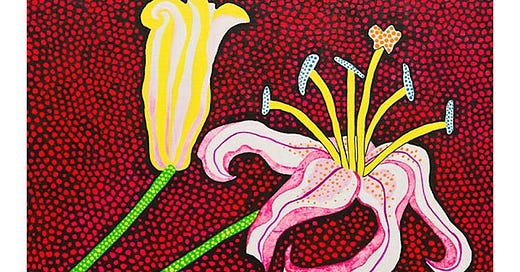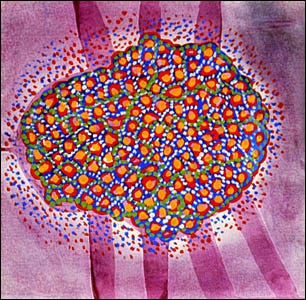The corpse flower, native to the tropical rainforests of the Malay Archipelago, is the largest flower in the world. It can grow up to three feet tall. It stinks.
There are more than three hundred species of roses. When we lived in Jersey City, I planted three bushes of knockout roses, which have everything, according to Southern Comfort: “showy, continuous blooms; compact growth habit; tough-as-nails constitution; and, best of all, no need to spray for black spot disease.” A paragraph further down explained that knockout roses are susceptible to a fatal virus spread by microscopic mites that ride the wind into gardens. This was during the pandemic and the paragraph felt a bit hostile. “But a tough-as-nails constitution!” I said to the paragraph. We were paranoid about demon mites surfing the gusts of wind but the roses grew just fine. Our daughter asked if mama knockout roses nurse the little baby knockout roses. I don’t know if the bushes are still there and flowering; I confess I would be proud if they are.
Catfish have around fifteen times more taste receptors than humans do. Jewel beetles can see infrared light. So can pit vipers. Silky ants can detect the smell of breast cancer in urine. Dolphins can’t smell anything.
The state flower of Florida is the orange blossom. Who picked the state flower? The legislature did, in 1909. They smell very nice. Some believe they’re an aphrodisiac. The Orange Blossom Special train ran between New York and Miami in the winter months from 1925 to 1953. It was luxurious. Whenever they made stops for provisions, they re-upped their supply of fresh fish and fresh flowers.
Immanuel Kant thought smell was “the most ungrateful and…most dispensable” of the senses. He wrote: “It does not pay to cultivate it or refine it at all in order to enjoy; for there are more disgusting objects than pleasant ones (especially in crowded places), and even when we come across something fragrant, the pleasure coming from the sense of smell is always fleeting and transient.” Weird guy, though, keep that in mind.
Another thing about jewel beetles. They’re able to sense the presence of fire at great distances, up to fifty miles away.
Hyssop flowers have a sweet smell. Purge me with hyssop, says the psalmist, and I shall be clean. The dead horse arum lily is said to smell like a dead horse that has begun to rot. This helps it attract blow flies, its pollinators. Researchers have long been interested in its thermogenic tricks.
Musk originally came from the secretion of a gland in the musk deer, but it is possible to derive the aromatic by other means. The medieval Islamic theologian Ibn Qayyim al-Jawziyya wrote that musk “is the king of the varieties of aromatics, their noblest and sweetest. It is that about which proverbs are coined, and other things are compared to, while it is not compared to anything else. It is the sand-dunes of the Garden.”
A musk deer is not really a deer.
Some people experience phantom smells—olfactory hallucinations—known as phantosmia. The smell can appear in just one nostril or both. Some Covid patients experience the smell of burning rubber or smoke (before losing their sense of smell entirely). This unpleasantness is typical of phantom smells. It would be nice to hallucinate a lavender aroma, but the clinical records instead indicate smells like rotten eggs or burning hair or strange chemicals. Although perhaps there is an issue in the sample here. If you can’t stop smelling something rotten, you go to the doctor; if you can’t stop smelling honey or lilacs, maybe you just count yourself lucky. Medical experts compare the phenomenon to phantom limb pain. This seems like a weird comparison, but maybe it’s not.
Parosmia is a different phenomenon—your smell is distorted. Coffee might smell like rotting garbage, for example. Again, unpleasant distortions are apparently far more common, although there have been rare cases of the reverse, known as euosmia—the smell of poop, say, might be confused with the aroma of pancake syrup.
What has been the most important flower in human history of the Common Era? Surely, it must be the poppy. They don’t offer much by way of aroma—they are said to smell “earthy,” a backhanded compliment. But they have other tricks.
After the Scots sustained heavy losses at the Battle of Neerwinden in 1693, the Earl of Perth wrote his sister: “During many months after, the ground was strewn with skulls and bones of horses and men, and with fragments of hats, shoes, saddles, and holsters. The next summer the soil, fertilised by 20,000 corpses, broke forth into millions of scarlet poppies.” We shall not sleep though poppies grow.
When the Japanese artist Yayoi Kusama was ten years old, she began to experience hallucinations, including flowers that spoke to her. These experiences continued to inform her art in adulthood. “One day I was looking at the red flower patterns of the tablecloth on a table, and when I looked up I saw the same pattern covering the ceiling, the windows, and the walls, and finally all over the room, my body and the universe,” she said. “I felt as if I had begun to self-obliterate, to revolve in the infinity of endless time and the absoluteness of space, and be reduced to nothingness.”
“Did you ever try to measure smell?” queried Alexander Graham Bell, a little more than a century ago. “Can you tell whether one smell is just twice as strong as another? Can you measure the difference between one kind of smell and another? It is very obvious that we have very many different kinds of smell, all the way from the odour of violets and roses up to asafoetida. But until you can measure their likeness and differences you can have no science of odour.”
The sensitivity in our odor receptors vary. Some people find that the pig pheromone androstenone smells like pee; some say it smells like body odor; some find it woody. Others say vanilla, others floral.
Then there’s the matter of context. In a 2001 experiment, participants were given vials labeled “parmesan” and “vomit.” They thought the former smelled good and the latter smelled disgusting. In fact, the vials contained precisely the same mixture of butyric acid—a substance that can be found in both parmesan and vomit.
On the topic of flower scents and other aromas, copy writers must of course be florid. Here’s one New York luxury candle shop’s blurb on jasmine flowers: “The floral scent of jasmine is rich, sweet, fruity, and sensual. Unlike other flowers, Jasmine also has a slight animalistic edge that smells tenacious and musky. The combination of feminine sweetness and masculine wildness make the smell of jasmine universally attractive.”
In Thailand, jasmine flowers are a symbol of motherhood.
I would have guessed that the phrase “stop and smell the roses” was at least a hundred years old, but it seems to have come into common use in the 1960s. Who knows what the origin was, but most trace it to the golfer Walter Hagen, who wrote in his 1956 autobiography: “Don’t hurry. Don’t worry. And be sure to smell the flowers along the way.” When Stephen Sondheim wrote the song “Everything’s Coming Up Roses” for the 1959 musical “Gypsy,” he said he wanted to invent a brand new phrase that seemed like it had been around for a very long time. Would have fooled me.
White roses smell differently than red roses. Datura flowers, in the nightshade family, have been used as both deadly poisons and hallucinogens. The evening blooms smell nice but the leaves are said to smell like rancid peanut butter if disturbed. Some find that shasta daisies smell like toejam. The flower that a protester stuck into the barrel of an M14 rifle in that famous photograph of the March on the Pentagon was a carnation. While a fresh carnation can smell sweetly of clove or spice, some cultivars have no aroma at all.
D.H. Lawrence had a lascivious way with flowers: “It was really a lovely day, the first dandelions making suns, the first daisies so white. The hazel thicket was a lace-work, of half-open leaves, and the last dusty perpendicular of the catkins. Yellow celandines now were in crowds, flat open, pressed back in urgency, and the yellow glitter of themselves.”
Cherry millipedes secrete toxins that smell like cherries and almonds.
The state flower of Maine is the White Pine Cone, which is not a flower at all.






I learned many things. Artful as usual. Thank you for whisking me away from my reality.